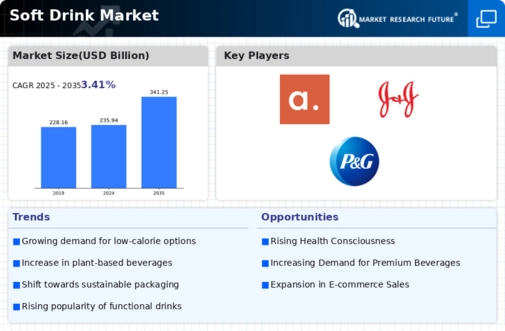Health and Wellness Trends
The soft drink market is increasingly influenced by health and wellness trends, as consumers become more aware of the nutritional content of their beverages. There is a growing demand for low-calorie, sugar-free, and functional drinks that offer health benefits. In 2025, it is estimated that beverages labeled as 'healthier options' will account for approximately 30% of total soft drink sales. This shift is prompting manufacturers to reformulate existing products and introduce new lines that cater to health-conscious consumers. Additionally, the rise of natural ingredients and organic certifications is becoming a focal point for brands aiming to appeal to this demographic. As the health trend continues to gain momentum, it is likely to reshape product offerings within the soft drink market.
Innovative Flavor Profiles
The soft drink market is currently experiencing a surge in demand for innovative flavor profiles. Consumers are increasingly seeking unique and exotic flavors that deviate from traditional offerings. This trend is particularly evident among younger demographics, who are more adventurous in their taste preferences. As a result, companies are investing in research and development to create novel flavor combinations, which could potentially enhance brand loyalty and attract new customers. In 2025, the introduction of limited-edition flavors has shown to increase sales by approximately 15% during promotional periods. This drive for innovation not only caters to consumer curiosity but also positions brands as trendsetters in the competitive landscape of the soft drink market.
Convenience and On-the-Go Consumption
The soft drink market is witnessing a notable shift towards convenience and on-the-go consumption. Busy lifestyles have led consumers to seek products that are easily accessible and portable. Single-serve packaging and ready-to-drink options are becoming increasingly popular, as they align with the fast-paced nature of modern life. In 2025, it is estimated that single-serve beverages account for nearly 40% of total soft drink sales in the US. This trend indicates a growing preference for products that can be consumed quickly, whether at work, during commutes, or while engaging in recreational activities. Companies are responding by enhancing distribution channels and optimizing packaging to meet this demand, thereby driving growth in the soft drink market.
E-commerce Growth and Digital Marketing
The soft drink market is experiencing a significant transformation due to the rise of e-commerce and digital marketing strategies. With the increasing penetration of the internet and mobile devices, consumers are more inclined to purchase beverages online. In 2025, online sales of soft drinks are projected to grow by 25%, reflecting a shift in consumer purchasing behavior. Brands are leveraging social media platforms and targeted advertising to engage with consumers, creating personalized marketing campaigns that resonate with their preferences. This digital approach not only enhances brand visibility but also facilitates direct-to-consumer sales, which could potentially increase profit margins. As e-commerce continues to evolve, it is likely to play a crucial role in shaping the future landscape of the soft drink market.
Sustainability and Eco-Friendly Practices
The soft drink market is increasingly prioritizing sustainability and eco-friendly practices in response to consumer demand for environmentally responsible products. Brands are adopting sustainable sourcing, reducing plastic usage, and implementing recycling initiatives to minimize their environmental footprint. In 2025, it is projected that 50% of consumers will prefer brands that demonstrate a commitment to sustainability. This shift is prompting companies to innovate in packaging solutions, such as biodegradable materials and reusable containers. Furthermore, transparency in sourcing and production processes is becoming essential for building consumer trust. As sustainability becomes a core value for many consumers, it is likely to drive purchasing decisions and influence brand loyalty within the soft drink market.














Leave a Comment